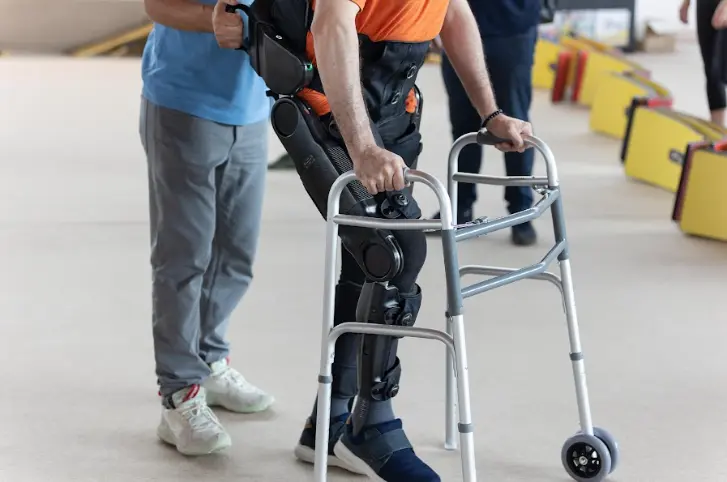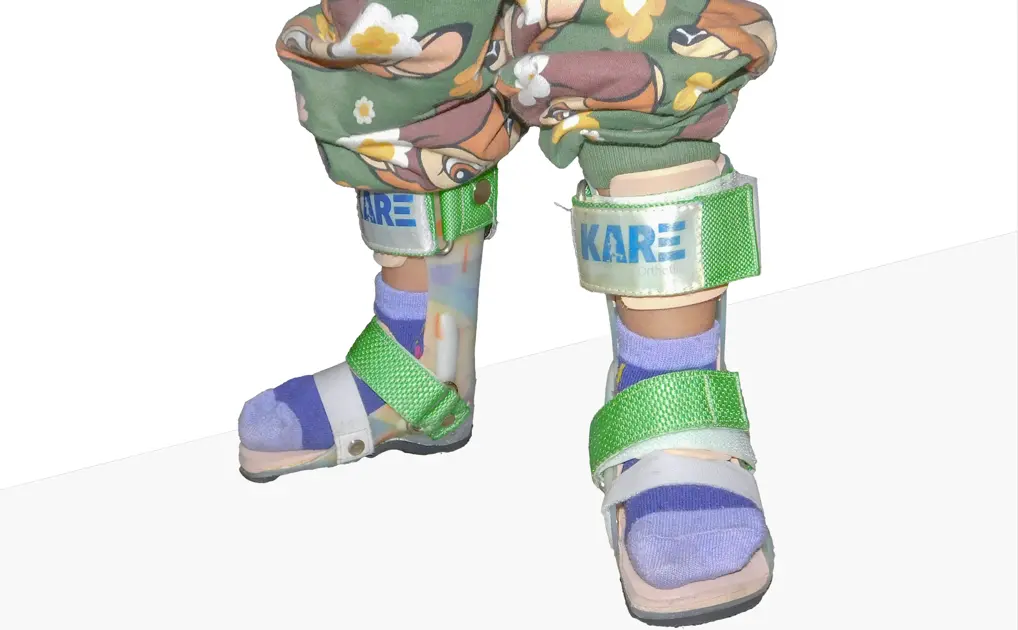
What is Paralysis
Paralysis or muscle failure is the result of a stroke, injury to the spinal cord, or severe neurological problems. It can affect, mentally and physically, and put a break on an active life. However, with paralysis treatment, it is now possible to take back control and regain movement. Proper orthotic devices or powered wheelchairs aid in restoring movement, improving posture, and enhancing mobility remarkably.
Causes and Symptoms of Paralysis
Paralysis happens when muscle function fails in any part of the human body. It may be a sudden impact or a gradual development. It may affect both sides of the person or just one side. However, in severe cases, the effect paralyses the entire body. Paralysis may strike people following a sudden stroke, after a spinal cord injury, multiple sclerosis, cerebral palsy, or neurological disorders.
Causes of Paralysis:
- Stroke
- Spinal cord injury
- Multiple sclerosis
- Cerebral palsy
- Neurological disorders
Symptoms of Paralysis in Legs:
- No voluntary movement in the legs
- Tingling or a numb feeling in the areas
- Extreme stiffness or spasticity
- No sensation
- Problems in walking or maintaining balance
- Incontinence
The severity of the symptoms depends on the root cause and the impact of partial or complete paralysis.
What Is the Best Treatment for Paralysis in India?
The best treatment for paralysis in India is a multi-disciplinary approach that includes the field of nursing, occupational therapy, physiotherapy, orthotics, and wheelchair technologists under the guidance of a medical practitioner. Treatment is done by a unified effort by several specialties to meet the specific patient’s requirements and is based on the reasons that caused the paralysis, such as stroke, spinal injury, or neurological conditions.
1. Medical Management
Top-notch neurologists, neurosurgeons, and rehab experts are available in India. They aim to stabilise the cause of paralysis. Using:
- Proper Medications to improve nerve signals and manage muscle spasms.
- Utilise surgery to relieve pressure or repair damage.
2. Nursing and caregiving
Nurses and caregivers play a vital role in paralysis care, providing physical assistance, rehabilitation support, and emotional strength. They monitor health round the clock, manage complexities, and coordinate multidisciplinary care. Family members often aid in daily activities and mobility, helping patients maintain independence and improve quality of life.
3. Physiotherapy and Occupational Therapy
Rehabilitation centres across India provide various types of therapies to help patients:
- Help get back their strength and flexibility.
- Help increase their coordination and balance.
- Relearn essential daily activities
4. Orthotic Device
Orthotics improve posture, mobility, and function for patients with paralysis. They are helpful for:
- Foot drop, which is helped by the ankle-leg orthosis (AFO).
- The KAFOs or HKAFOS support the legs. They provide the best support for upper limbs and hand and hand functions, helping to restore freedom and prevent complications.
5. Wheelchair Solutions
These depend on the mobility level; patients benefit from:
- Manual wheelchairs, which may be self- or attendant-propelled
- Electric/power wheelchairs that are joystick or head control
- Custom seating systems for posture and pressure relief
Advanced options include standing wheelchairs and chairs with smart tech for home and outdoor mobility.
6. Assistive Technology and Robotics
India is home to clinics that use:
- Highly advanced Functional Electrical Stimulation (FES)
- Hi-tech Robotic exoskeletons
- Brain-computer interface devices (in experimental stages)
to help patients achieve functional movement.
The best treatment for paralysis in India does not have a standard parameter or solution; this strategic plan includes doctors, therapists, assistive devices, and continuous support.
What is Orthotics?

Orthotics are customisable, prebuilt devices, including shoe inserts, splints, braces, or supportive frameworks that are typically used to support and align your body, feet and ankles. The devices can relieve foot or ankle pain, support gait when you have trouble walking, or provide external support for balance and movement. These support tools can lower pressure, improve your posture, and help your body move more easily.
Orthotics help in:
- Stabilise weak joints and limbs
- Improve posture and body alignment
- Prevent muscle contractures or deformities
- Assist with walking or standing
- Relieve pain and reduce fatigue
- Enhance safety and independence
Often, orthotics are used alongside physical therapy, occupational therapy, and wheelchairs as part of a complete rehabilitation plan.
How Orthotics Help in Post Paralysis Treatment
Orthotics, such as custom-made braces and splints, help in paralysis treatment by supporting weak limbs and muscles. They gradually improve stability and the function of affected limbs. Orthotics are effective in correcting deformities, preventing injury, enabling greater independence in daily activities, improving alignment, and helping in movement.
- Stabilisation and Support: Orthotic devices offer support to the weak joints and muscles in the spine, hips, knees, ankles, and feet of the user. The devices help to reduce injury risk from sudden movement.
- Improved Posture and Alignment: Orthotic devices are effective in correcting posture and improving skeletal deformities. Thus, helping individuals to sit, stand, or walk with better balance. They also reduce pressure-related complications.
- Improved Mobility and Function: AFOs and KAFOs help people with paralysis move better by enabling them to stand, walk, or move independently.
- Prevention of Secondary Complications: Orthotics help to maintain proper positioning and prevent:
- Contractures in muscles
- Stiffness in Joints
- Pressure sores
- Pain from misalignment
- Rehabilitation and Therapy Support: Orthotics assist in gait training, muscle re-education, and improving motor function; thus, they are an essential part of physical and occupational therapy.
KARE Prosthetics & Orthotics is considered among the best providers in India, offering customised braces, gait aids, and rehabilitation support.
Types of Orthotic Devices Used in Post Paralysis Treatment
Orthotic devices stabilise or assist weakened limbs. They’re essential in restoring movement, preventing muscle contractures, and enabling functional tasks for people with paralysis:
1. Ankle-Foot Orthosis (AFO)
- Supports the ankle and foot
- Ideal for foot drop, partial leg paralysis, or stroke recovery
- Prevents foot drag and improves walking safety
2. Knee-Ankle-Foot Orthosis (KAFO)
- Supports the knee, ankle, and foot
- Used in complete leg paralysis or spinal injuries
- Allows assisted standing and limited walking
3. Hip-Knee-Ankle-Foot Orthosis (HKAFO)
- Includes hip support along with leg stabilisation
- Helpful for paraplegia or spina bifida
- Enables upright posture and limited mobility with therapy
4. Spinal Orthoses (TLSO or LSO)
- Support the thoracic or lumbar spine
- Used after spinal cord injury, surgery, or for scoliosis
- Improves alignment and reduces pain
5. Upper Limb Orthoses
- Wrist-hand orthoses, elbow supports, hand splints
- For stroke, nerve injuries, or multiple sclerosis
- Helps maintain hand posture and grip
6. Functional Electrical Stimulation (FES) Devices
FES are used explicitly for neurological conditions like stroke or spinal cord injury. They help to promote muscle activity, improve walking patterns, and prevent atrophy.
An FES orthosis consists of a AFO with an electrical stimulation unit with electrodes. The electrical unit delivers controlled electrical pulses to nerves that control muscles in the leg, causing them to contract and move the foot at the ankle. AFOs with FES when prescribed correctly can help deliver a smoother, safer and efficient gait in conditions like foot drop.
“The AFO orthosis provides stability for standing and walking, while the FES assists with lifting the foot during the swing phase.“
What is the role of Wheelchairs for Paralysis Treatment
Wheelchairs become essential for daily living for individuals with paralysis. The suitable wheelchair becomes a source of comfort, independence, and support during recovery.
Manual wheelchairs:
- Self-propelled (for users with upper-body strength)
- Attendant-propelled (for users needing caregiver support)
Electric wheelchairs:
- Operated with joystick, head, or chin controls
- Offer advanced features like reclining seats and obstacle detection
- Suitable for users with limited upper-body strength
How to Choose the Right Orthotic or Wheelchair?
While choosing a orthotics or wheelchairs, check the following:
- Assessment First: Paralysis is different for each individual. Therefore, ensure that a qualified orthotist or rehabilitation expert assesses the strength, balance, and function of the devices. A thorough assessment will help the orthotist frame the right prescription.
- Fit Matters: You must check the sizing and adjustment features, as an ill-fitting orthosis or wheelchair can do more harm than good.
- Integration with Therapy: The orthotics and wheelchairs must align with the physical and occupational therapy for the best outcome.
Frequently Asked Questions
1. What is the role of orthotics in paralysis treatment?
Orthotics play a crucial role in paralysis treatment. They support, enhance mobility, and functional recovery. Moreover, they offer stability and correct deformities and spasticity. Therefore, improving the person’s ability to do daily tasks and enjoy a good quality of life.
2. What orthosis is used for paraplegia?
Orthoses, such as Hip-Knee-Ankle-Foot Orthoses (HKAFOs), Knee-Ankle-Foot Orthoses (KAFOs), and Ankle-Foot Orthoses (AFOs), are preferably used for paraplegia and to assist with standing and walking.
3. What is the brace for paralysed legs?
Several types of braces can help with mobility, including Knee-Ankle-Foot Orthoses (KAFOs) and C-Braces. With KAFOs, one can get support and stability for the entire leg, while microprocessor-controlled C-Braces offer greater dynamic support for a more natural gait. The use of specific braces depends on the extent and area of the paralysis and the needs of the person.
4. What orthosis is used for cerebral palsy?
The most preferred orthosis for cerebral palsy (CP) is the ankle-foot orthosis (AFO). It is used for improving gait and providing stability. In some exceptional cases, Knee-ankle-foot orthoses (KAFOs) or hip-knee-ankle-foot orthoses (HKAFOs) are used. AFOs are primarily for ambulant children with CP.
Final Thoughts
Orthotics enhance mobility, comfort and self-esteem for individuals with paralysis. This external support keeps injured limbs stable, aligns spinal deformities, and provides comfort to people when standing and walking. They helping people heal, overcome injuries and painful situations by providing significant support for step-by-step recovery, rehabilitation, and therapy.
Power wheelchairs designed specifically for individuals with paralysis offer greater freedom to move and enable them to live life on their terms.
Why KTWO Healthcare Become the Best Post Paralysis Treatment in India
KTWO Healthcare is a trusted name in mobility and rehabilitation solutions, dedicated to improving the quality of life for people with physical challenges, including those living with paralysis. Under KTWO Healthcare, two specialized divisions work hand in hand:
- KARE Prosthetics & Orthotics: Experts in designing and delivering custom orthotics tailored to each individual’s needs. KARE ensures precise fitting, thorough training, and continuous support, helping patients achieve safety, comfort, and greater independence.
- ScootMobility: Specialists in wheelchairs, mobility scooters, and travel-friendly mobility aids that restore freedom of movement and confidence for users in everyday life.
Together, KARE Prosthetics & Orthotics and ScootMobility, under the KTWO Healthcare umbrella, provide end-to-end mobility and orthotic care, from advanced orthotic devices to reliable wheelchair solutions, ensuring each patient receives not just a product, but a lifelong support system.




